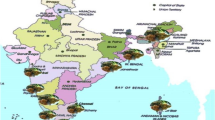Abstract
Litchi chinensis Sonn. is a common fruit of India especially grown in the state of Bihar and surrounding states. Common forest regions, botanical gardens, and plant conservatories were surveyed at a regular interval of 3 months during the period April 2002 to March 2012 for the collection of diseased samples under the AICOPTAX program. During the course of the survey a number of diseases such as tar leaf spot were observed. Older leaves show a higher percentage of infections than younger leaves. The diseased leaves serve as the source of primary infection. The leaf spots spread rapidly during humid and rainy months. The lesions coalesced at the later stages. The diseased leaves show yellow brown to brick red areas, mostly towards the margins. The percentage of disease incidence varied in different localities. The coloured areas gradually become light brown and show black pinheads resembling pycnidia. Pestalotia pauciseta Sacc., Botryodiplodia theobromae Pat., and Colletotrichum gloeosporoides occur very commonly in litchi orchards, causing tar disease. Another serious leaf spot disease is incited by Microdiplodia litchi and Clitocybe tabescence. Sudden wilt caused by Fusarium sp., dieback from Phomopsis, and foliar necrosis caused by Gloeosporium spp. are reported. Some of the post-harvest diseases are carried along with the fruits during transit and storage. Among these pathogens, such as Botryodiplodia theobromae, Colletotrichum gloeosporioides, Cylindrocorpon forkinense, Phomopsis spp. and species of Pestalotia are the most important and need attention as they also cause diseases on the plants. Spraying of leaf extracts of Andrographis paniculata, Azadirachta indica, Plumbago zeylanica, and Ocimum sactum reduced the infection; however, fungicides such as bavistin, topsin M, baycor, and dithiocarbmates were found to be very effective to control the disease.
Access this chapter
Tax calculation will be finalised at checkout
Purchases are for personal use only
Similar content being viewed by others
References
Butani DK (1977) Pests of litchi in India and their control. Fruits 32:269–273
Chadha KL (1968) Litchi cultivation in India. Indian Hortic 12:13–16
Dass CS, Choudhary KR (1958) Floral biology of litchi (Litchi chinensis Sonn.) South Indian Hortic 6:17–22
Dwivedi RS, Pathak SP (1978) Proc Natl Acad Sci. India 48(B):287–288
Dixit SN, Tripathi NN, Tripathi SC (1978) Fungitoxicity of some seed extracts. Natl Acad Sci Lett 1(8):287–288
Jamaluddin, Tandon MP (1973) Some new leaf spot diseases. Curr Sci 42:103
Jamaluddin, Tandon MP (1976) Some new market diseases of vegetables and fruits. Indian Phytopathol 29:74–75
Jamaluddin, Tandon MP, Tandon RN (1971) A storage rot of tomato fruits (Lycopersicon esculentum) caused by Geotrichum candidum Link ex Pers. Curr Sci 40:415–416
Jamaluddin, Tandon MP, Tandon RN (1975) Rot of fruits of litchi (Litchi chinensis) in marketing process. Indian Phytopathol 28:530–531
Jamalulddin, Goswami MG, Ojha BM (2004) Fungi of India (1989-2001). Scientific Publishers, Jodhpur
Kotur SC, Singh HP (1993) Leaf sampling technique in litchi (Litchi chinesis Sonn.). Indian J. Agric Sci 63:632–638
Kotur SC, Singh HP (1994) Varietal differences in leaf nutrient composition of litchi (Litchi chinesis Sonn.) Indian J Hortic 51:59–62
Kumar R, Sachan SN (1979) Effect of some plant extracts on the conidial germination of Curvularia pallescens. Indian Phytopathol 32(3):489
Kunwar R, Singh R (1993) Note on nutritional survey of litchi orchards in Doon Valley of Garhwal Hills of Uttar Pradesh. Prog Hortic 25:164–165
Mallik PC, Singh DL (1965) Hunger sign in litchi. Indian Agriculturist 91:127–138
Pandey RM, Sharma HC (1989) The litchi. ICAR Publication, New Delhi
Pandey S, Misra AP (1975) Mycorrhiza in relation to growth and fruiting of Litchi chinesis Sonn. J Indian Bot. Soc 54:280–293
Rao DP, Mukherjee SK, Ray RN (1985) Nutritional studies in litchi orchards in different districts of West Bengal. Indian Hortic 42:1–7
Ray PK, Sharma SB, Mishra KA (1984) Important litchi cultivars of Bihar. Indian Hortic 30(1):9–13
Singh HP 1992 Physico-chemical evaluation of litchi cultivars in South Bihar. In: National seminar on recent developments in litchi production, 30–31 May, RAU, Pusa
Singh HP, Yadav IS (1988) Physico-chemical changes during fruit development in litchi cultivar. India J Hortic 45:212–218
Singh HP, Yadav IS (1992a) CHES-1, a promising selection of litchi. In: National Seminar on recent development in litchi production, RAU, Pusa, 30–31 May 1992
Singh HP, Yadav IS (1992b) Studies on seed germination in litchi cultivars affected by physiological maturity. In: National seminar on recent developments in litchi production, RAU, Pusa, 30–31 May, p 16
Singh LB, Singh OP (1954) The litchi. Superintendent Printing Press, Allahabad, p 110
Singh HP (1998) Genetic diversity, breeding and utilisation of the genepool of litchi. In: Arora RK, Roa R (eds) Tropical fruits in Asia, IPGRI, pp 171–184
Singh HP, Kumar KK (1988) Litchi growing in India. Chona Hortic 5(1):22–32
Verma SK, Jain BP, Das SR (1980) Preliminary studies on the evaluation of the effect of growth substances with minor elements in controlling fruit drop in litchi (Litchi chinesis Sonn.) Haryana J Hortic 10:4–10
Yadav IS Singh HP (1992) Genetic resources of litchi in India. In: National seminar on recent developments in litchi production, RAU, Pusa, 30–31 May 1992
Author information
Authors and Affiliations
Corresponding author
Editor information
Editors and Affiliations
Rights and permissions
Copyright information
© 2017 Springer Nature Singapore Pte Ltd.
About this chapter
Cite this chapter
Pandey, S.K., Roy, A.K., Chandel, S.C.R., Rani, A., Singh, R., Mishra, R.S. (2017). Lychee Diseases and its Viable Control. In: Kumar, M., Kumar, V., Bhalla-Sarin, N., Varma, A. (eds) Lychee Disease Management. Springer, Singapore. https://doi.org/10.1007/978-981-10-4247-8_10
Download citation
DOI: https://doi.org/10.1007/978-981-10-4247-8_10
Published:
Publisher Name: Springer, Singapore
Print ISBN: 978-981-10-4246-1
Online ISBN: 978-981-10-4247-8
eBook Packages: Biomedical and Life SciencesBiomedical and Life Sciences (R0)




